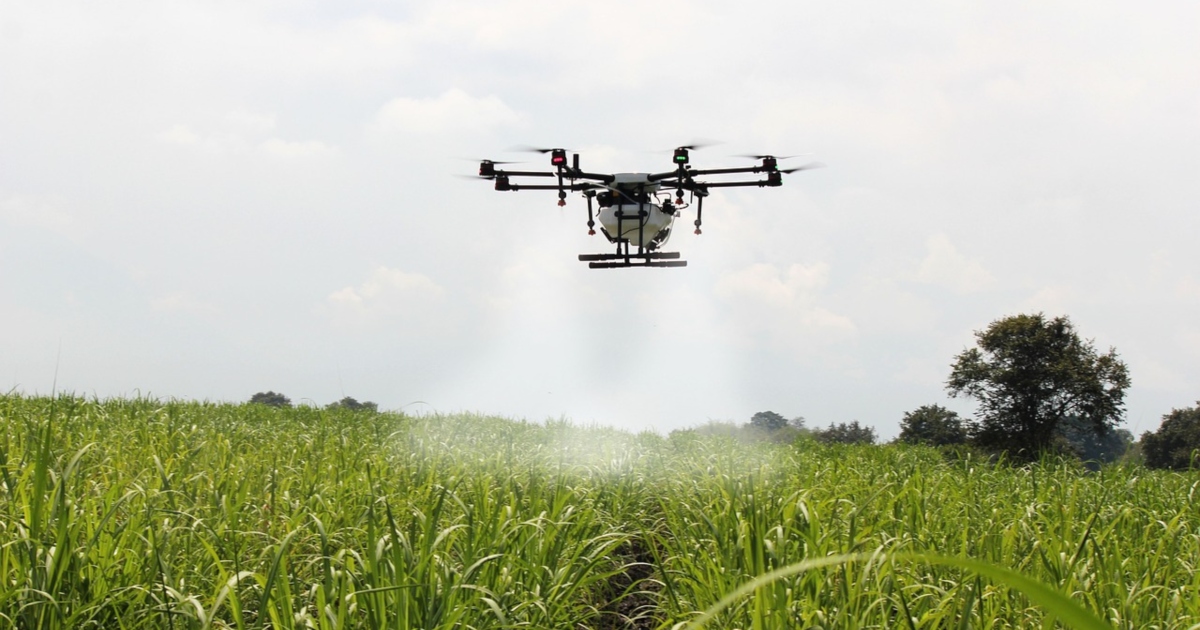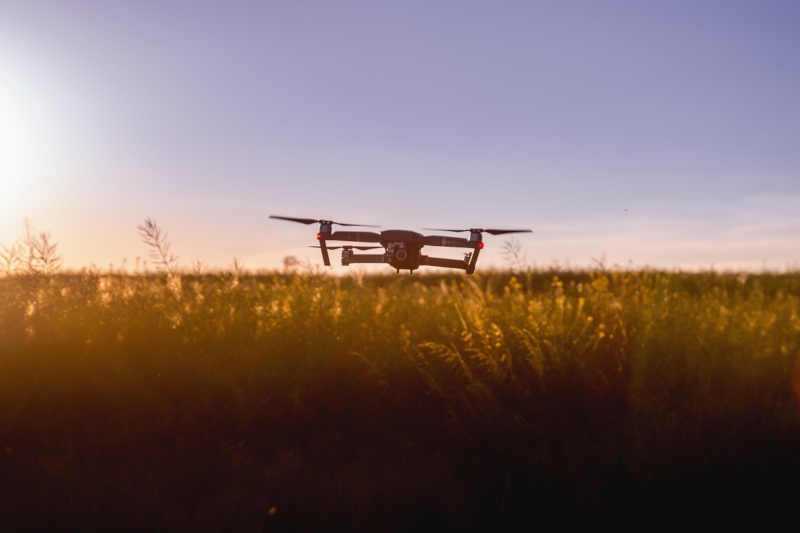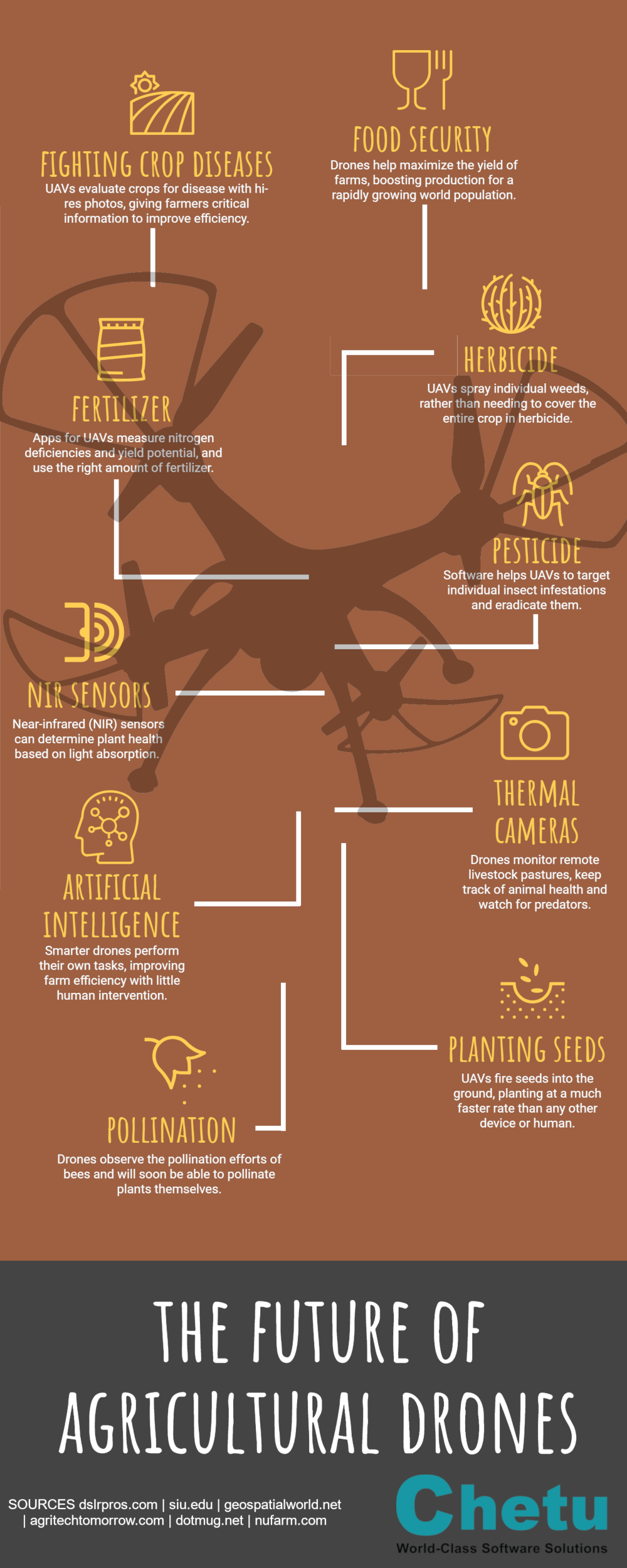Drone technology is a phenomenal innovation that continues to have far-reaching effects across today’s society, transforming our lives and the way we do business.
The agricultural industry seems to have embraced drone technology with open arms, using these advanced tools to transform modern farming.

High-tech drones allow farmers, and the drone pilots that operate them, to increase efficiency in certain aspects of the farming process. From crop monitoring to planting, livestock management, crop spraying, irrigation mapping, and more.
Below we dive deep into the agricultural drone market and its many applications, along with a look at the future of this exciting industry and what you can do to get started as an agricultural drone pilot.
UNDERSTANDING THE AGRICULTURAL DRONE MARKET
Agricultural drones help to achieve and improve what’s known as precision agriculture.
This approach to farming management is based on observing, measuring, and taking action based on real-time crop and livestock data. It erases the need for guesswork in modern farming and instead gives farmers the ability to maximize their yields and run more efficient organizations, all while enhancing crop production.
In recent years the cost of agriculture drones has rapidly declined, which has not only led to the explosion of drone use cases in agriculture but has made it a no-brainer investment for modern farmers.
In fact, the agricultural drone market is expected to grow over 38% in coming years. Driven by growing population levels and changing climate patterns, the need for efficient agriculture is only going to become more important.
There are multiple uses for agricultural drones, including:
- Scouting land and crops
- Checking for weeds and spot treating plants
- Monitoring overall crop health
- Managing livestock and monitoring for health issues
- And more
Drones are equipped with technology like propulsion systems, infrared cameras, GPS and navigation systems, programmable controllers, and automated flight planning. Plus, with custom-made data processing software any collected information can instantly be put to use towards better management decisions.
DRONES AND AGRICULTURE: A MATCH MADE IN HEAVEN
Drones are transforming how agriculture and farming are done.
By implementing drone technology, farms and agriculture businesses can improve crop yields, save time, and make land management decisions that’ll improve long-term success.
Farmer’s today have a variety of complex factors that influence the success of their farms. From water access to changing climate, wind, soil quality, the presence of weeds and insects, variable growing seasons, and more.
As a result, farmers are turning to high-level drone technology to help remedy these problems, and provide fast and efficient solutions.
Agricultural drones allow farmers to obtain access to a wealth of data they can use to make better management decisions, improve crop yields, and increase overall profitability.
Drones can be used to collect data related to crop yields, livestock health, soil quality, nutrient measurements, weather and rainfall results, and more. This data can then be used to get a more accurate map of any existing issues, as well as create solutions based upon extremely reliable data.
The agriculture industry is no stranger to embracing changing technological trends to streamline business. The use of drones in agriculture is the next technological wave that’ll help agricultural businesses meet the changing and growing demands of the future.
HOW AGRICULTURAL DRONES ARE USED: 6 INNOVATIVE METHODS

The use of drones in agriculture is here to stay.
Drone technology can help to accomplish once time-consuming and difficult tasks, all while reducing costs across the board.
You can expect the current uses of drones in agriculture to continue to evolve as the industry matures and new technology is introduced.
Currently, there are six common uses of agricultural drones, which we profile below:
1. Soil and Field Analysis
At the beginning, middle, and end of a crop cycle drones can be used to help obtain useful data surrounding the quality of the existing soil. By obtaining 3D maps of existing soil, you’ll be able to see if there are any issues surrounding soil quality, nutrient management, or soil dead zones.
This information can help farmers determine the most effective patterns for planting, managing crops, soil, and more. Ongoing monitoring can help to better utilize water resources, and more effectively manage crop nutrient levels.
2. Seed Planting
Drone planting is a relatively newer technology and not as widely used, but some companies are experimenting with drone planting. Essentially, manufacturers are experimenting with custom systems that have the ability to shoot seed pods into prepared soil.
Drone startup companies have been instrumental in developing unique drone technologies to assist with a wide range of ecological and agricultural issues. For example, the company DroneSeed is using unmanned aircraft capable of delivering up to 57 pounds of payload in the form of tree seeds, herbicides, fertilizer and water per aircraft per flight to assist reforestation and replanting projects.
This technology helps to minimize the need for on-the-ground planting, which can be costly, time-intensive, and strenuous work.
This same drone technology can be adapted and applied to a wide range of farm types, reducing overall planting times and labor costs across the board.
3. Crop Spraying and Spot Spraying
Crops require consistent fertilization and spraying in order to maintain high yields. Traditionally this was done manually, with vehicles, or even via airplane. These methods are not only inefficient, and burdensome, but they can be very costly as well.
With approval from the FAA, Drones can be equipped with large reservoirs, which can be filled with fertilizers, herbicides, or pesticides. Using drones for crop spraying is much safer and cost-effective. Drones can even be operated completely autonomously and programmed to run on specific schedules and routes.
For example, if there’s a fungus breakout in a certain section of the crops, drones can be used to spot treat the issue. With the speed at which drones can operate, you can diagnose and treat potential crop issues before they become a widespread issue across the entire farm.
Spot spraying of crops used to be incredibly difficult. If you had an issue with weeds or a certain crop, the entire acreage would have to be sprayed.
This is a huge waste of time and resources, as someone will have to walk the entire acreage, plus there are the overall costs of pesticides and the associated environmental cost of chemical usage.
With spot spraying afforded by drones, this same task can be accomplished in less time, with fewer monetary resources, and a reduced environmental cost.
4. Crop Mapping and Surveying
One of the biggest advantages of using drone technology is the ease and effectiveness of large-scale crop and acreage monitoring. In the past, satellite or plane imagery was used to help get a large scale view of the farm, while helping to spot potential issues.
However, these images were not only expensive but lacked the precision that drones can provide. Today, you can not only obtain real-time footage but also time-based animation which can illuminate crop progression in real-time.
With drone mapping and surveying, technology decisions can now be made based on real-time data, not outdated imagery, or best-practice guesswork.
With near infrared (NIR) drone sensors you can actually determine plant health based upon light absorption, giving you a birds-eye view of the overall farm health. We recently interviewed a drone pilot who used NIR to help vineyard owners determine the health of their grapevines.
With agriculture drones you’ll be able to collect information like:
- The overall crop and plant health
- Land distribution based on crop type
- Current crop life cycle
- Detailed GPS maps of current crop area
The end result is simple, drones can help to maximize land and resource usage, and help farmers better determine crop planting locations.
5. Irrigation Monitoring and Management
Irrigation can be troublesome. With miles and miles of irrigation, issues are bound to arise. Drones that are equipped with thermal cameras can help to spot irrigation issues, or areas that are receiving too little or excessive moisture.
With this information, crops can be better laid out to maximize drainage, adhere to natural land runoff, and avoid water pooling, which can damage sensitive crops.
Water and irrigation issues are not only costly but can ruin crop yields as well. With drone surveying, these issues can be spotted before they become troublesome.
6. Real-Time Livestock Monitoring
Some drones are equipped with thermal imaging cameras that enable a single pilot to manage and monitor livestock. This allows farmers to keep track of livestock a much greater frequency, and with less time and staff investment.
The drone operator can quickly check in on herd to see if there are any injured or missing livestock, as well as see livestock who are giving birth. Drones are used to keep an eye on the heard at all times, a once costly and time-intensive task.
Plus, thermal imaging will also help to keep an eye out for any livestock predators, which can be a huge advantage for some farm owners.
Launching Your Career as an Agriculture Drone Pilot
Maximizing yields, minimizing costs, and future-proofing farms.
It’s easy to see why there’s so much excitement surrounding agriculture drones. Farms and agriculture businesses that embrace drones will quickly outcompete those who don’t.
As a result, agriculture drone pilots will become a pivotal asset to these companies.
Sounds like a thrilling and future-proof career to be in.
The field of agricultural drone work is still in its infancy. But, the biggest limiting factor in the growth of the field is the lack of trained pilots.
Luckily, if you’re reading this, you’re one click away from becoming a certified drone pilot. With the proper expert training and passion for the field, you can help to transform the way farming is done, and secure your place in a lucrative and rewarding industry.
As a professional agricultural drone pilot, you’ll be on the forefront of capturing farm, livestock, and land data, and quickly transforming this into actionable insights for farm production.
Once certified there are multiple methods for agriculture drone success including:
- Operating on a consultant basis offering land evaluation, and action-based farm improvement maps based on thermal and advanced imaging.
- Creating automated drone systems for existing farms to handle planting, spraying, and regular crop management.
- Contract work for regular crop monitoring, spraying, and detailed analyses to help maximize farm yields.
- Farm employment for big agricultural operators who need a dedicated agricultural drone pilot.
- Creating detailed maps for turf and other outdoor land management facilities.
- Executing in-depth studies about plant and crop survival and viability under different weather and climate conditions.
Expect the future of drone work, types of drone contracts and jobs, and business opportunities to continue to grow as adoption becomes more mainstream.
So, what does the future of agriculture drone technology hold?
By now, you can see there’s already a wide range of different drone applications currently in existence.
Like most things technology-related, you can expect this field to evolve at a rather quick rate.
The future of this industry is in the hands of farmers and the drone operators they employ.
Whether we’ll be looking at fleets of autonomous drones, hybrid aerial and ground data collection fleets, or simply highly-trained individual pilots, the future for agriculture drone work is bright.
As safety guidelines, drone best practices, insurance policies, and drone camera and sensor technology continues to evolve, so will drone applications in agriculture.









